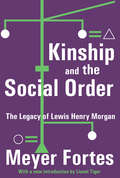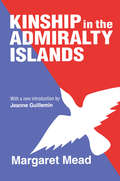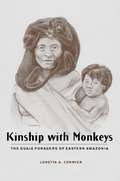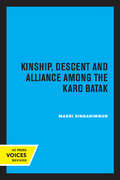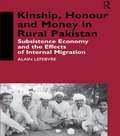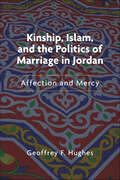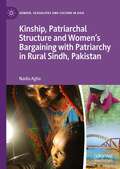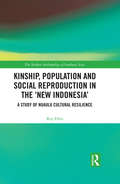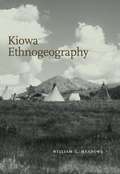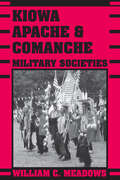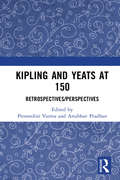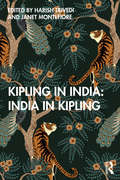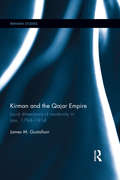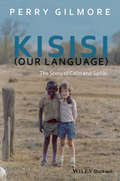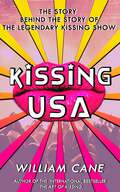- Table View
- List View
Kinship and the Social Order: The Legacy of Lewis Henry Morgan
by Meyer FortesOne of the world's most eminent social anthropologists draws upon his many years of study and research in the field of kinship and social organization to review the development of anthropological theory and method from Lewis Henry Morgan (1818-1881) to anthropologists of the 1960s. It is the central argument of this book that the structuralist theory and method developed by British and American anthropologists in the study of kinship and social organization is the direct descendant of Morgan's researches. The volume starts with a re-examination of Morgan's work. Professor Fortes demonstrates how a tradition of misinterpretation has disguised the true import of Morgan's discoveries. He follows with a detailed analysis of the work of Rivers and Radcliffe-Brown and the generation of anthropologists inspired by them. The author states his own point of view as it has developed in the framework of modern structuralist theory, with ethnographic examples examined in depth. He shows that the social relations and institutions conventionally grouped under the rubric of kinship and social organization belong simultaneously to two complementary domains of social structure, the familial and the political. Meyer Fortes' contribution to the field of anthropology can best be understood in the context of balance of forces between these domains of the personal and public. In the latter part of the book, he gives detailed attention to the principal conceptual issues that have confronted research and theory in the study of kinship and social organizations since Morgan's time. He shows that kinship institutions are autonomous, not mere by-products of economic requirements, and demonstrates the moral base of kinship in the rule of amity.
Kinship in Action: Self and Group
by Andrew Strathern Pamela J StewartFor courses in Social Organization, Kinship, and Cultural Ecology.Kinship has made a come-back in Anthropology. Not only is there a line of noted, general, introductory works and readers in the topic, but theoretical discussions have been stimulated both by technological changes in mechanisms of reproduction and by reconsiderations of how to define kinship in the most productive ways for cross-cultural comparisons.In addition, kinship studies have moved away from the minutiae of kin terminological systems and the “kinship algebra” often associated with these, to the broader analysis of processes, historical changes and fundamental cultural meanings in which kin relationships are implicated. In this changed, and changing context both Andrew Strathern and Pamela J. Stewart -- both of the University of Pittsburgh -- bring together a number of interests and concerns, in order to provide pointers for students, as well as scholars, in this field of study. Taking an explicitly processual approach, the authors examine definitions of terms such as kinship itself, approach the topic in a way that is invariably ethnographic, and deploy materials from field areas where they themselves have worked.
Kinship in the Admiralty Islands
by Jeanne GuilleminThe Manus of New Guinea's Pere village were Margaret Mead's most favored community, the people to whom she returned five times before she died in 1978. Kinship in the Admiralty Islands is the classic and only thorough description of their complex rules of marriage and family relations. It draws on Mead's 1928-1929 field work, conducted with her second husband, New Zealander Reo Fortune, and benefits by her being able to cross-check her data with his. Written in 1931, Kinship followed Mead's first and very popular book on the Manus, Growing Up in New Guinea, which was criticized by other anthropologists for being too general in scope. In Kinship Mead succeeded in demonstrating her thorough knowledge of this Melanesian group in the specific terms prized by her scholarly colleagues, while also describing in depth Manus social structure.Kinship in the Admiralty Islands describes an intricate system of social restraints and kinship ties and their impact on the local economy. The Manus' predilection for adoption, for example, allows surrogate fathers to make extended marriage payments, while in the next generation their adopted sons will take on the same responsibility for other young men in the new kin network. Mead reviews other kinship rules, such as avoidance behavior between in-laws of the opposite sex, early betrothals, other forms of adoption, and a range of deference behavior and joking relations among kin. In this work, Mead walks a fine line between functionalist kinship analysis of the British school of Radclife Brown and the cultural-and-personality orientation of Americans in the school of Franz Boas.Jeanne Guillemin's new introduction provides a lively in depth description of Margaret Mead's career in the early days of anthropology, the sometimes negative reactions of her contemporaries to her work, and her reasons for writing Kinship in the Admiralty Islands, as well as Mead's later reactions to how "her Manus" entered the modern world.Margaret Mead was noted for directing her writings to both scholar and laymen alike. Kinship in the Admiralty Islands will be of interest to anthropologists and general readers interested in the peoples of the South Pacific.Margaret Mead was curator of ethnology of the American Museum of Natural History. She was the author of many books including Continuities in Cultural Evolution (available from Transaction), The Study of Culture at a Distance, The Mountain of Arapesh, and From the South Seas: Studies of Adolescence and Sex in Primitive Societies. Jeanne Guillemin is a professor of anthropology at Boston College and editor of Anthropological Realities: Readings in the Science of Culture, also available from Transaction.
Kinship in the Age of Mobility and Technology: Migrant Family Mobilities in the Contemporary Global Novel (Palgrave Studies in Mediating Kinship, Representation, and Difference)
by Lamia TayebThis volume aims to address kinship in the context of global mobility, while studying the effects of technological developments throughout the 20th century on how individuals and communities engage in real or imagined relationships. Using literary representations as a spectrum to examine kinship practices, Lamia Tayeb explores how transnational mobility, bi-culturalism and cosmopolitanism honed, to some extent, the relevant authors’ concerns with the family and wider kinship relations: in these literatures, kinship and the family lose their familiar, taken-for-granted aspect, and yet are still conceived as ‘essential’ spheres of relatedness for uprooted individuals and communities. Tayeb here studies writings by Hanif Kureishi, Zadie Smith, Monica Ali, Jhumpa Lahiri, Khaled Housseini and Nadia Hashimi, working to understand how transnational kinship dynamics operate when moved beyond the traditional notions of the blood relationship, relationship to place and identification with community.
Kinship to Kingship: Gender Hierarchy and State Formation in the Tongan Islands
by Christine Ward GaileyHave women always been subordinated? If not, why and how did women's subordination develop? Kinship to Kingship was the first book to examine in detail how and why gender relations become skewed when classes and the state emerge in a society. Using a Marxist-feminist approach, Christine Ward Gailey analyzes women's status in one society over three hundred years, from a period when kinship relations organized property, work, distribution, consumption, and reproduction to a class-based state society. Although this study focuses on one group of islands, Tonga, in the South Pacific, the author discusses processes that can be seen through the neocolonial world. This ethnohistorical study argues that evolution from a kin-based society to one organized along class lines necessarily entails the subordination of women. And the opposite is also held to be true: state and class formation cannot be understood without analyzing gender and the status of women. Of interest to students of anthropology, political science, sociology, and women's studies, this work is a major contribution to social history.
Kinship with Monkeys: The Guajá Foragers of Eastern Amazonia (Historical Ecology Series)
by Loretta CormierIntrigued by a slide showing a woman breast-feeding a monkey, anthropologist Loretta A. Cormier spent fifteen months living among the Guajá, a foraging people in a remote area of Brazil. The result is this ethnographic study of the extraordinary relationship between the Guajá Indians and monkeys. While monkeys are a key food source for the Guajá, certain pet monkeys have a quasi-human status. Some infant monkeys are adopted and nurtured as human children while others are consumed in accordance with the "symbolic cannibalism" of their belief system.The apparent contradiction of this predator/protector relationship became the central theme of Cormier's research: How can monkeys be both eaten as food and nurtured as children? Her research reveals that monkeys play a vital role in Guajá society, ecology, economy, and religion. In Guajá animistic beliefs, all forms of plant and animal life—especially monkeys—have souls and are woven into a comprehensive kinship system. Therefore, all consumption can be considered a form of cannibalism.Cormier sets the stage for this enlightening study by examining the history of the Guajá and the ecological relationships between human and nonhuman primates in Amazonia. She also addresses the importance of monkeys in Guajá ecological adaptation as well as their role in the Guajá kinship system. Cormier then looks at animism and life classification among the Guajá and the role of pets, which provide a context for understanding "symbolic cannibalism" and how the Guajá relate to various forms of life in their natural and supernatural world. The book concludes with a discussion of the implications of ethnoprimatology beyond Amazonia, including Western perceptions of primates.
Kinship, Descent and Alliance among the Karo Batak
by Masri SingarimbunThe topic of this monograph is kinship and affinal relations among the Karo Batak. My reason for selecting this topic is my belief that an understanding of the Karo system of social relations between kin and relatives by marriage is the necessary starting point for an understanding of most other aspects of Karo culture and society. Moreover, the Karo kinship system is similar to the kinship systems of numerous other peoples—including other Batak—which have become the focus of considerable anthropological interest and much theoretical debate.—From the Preface This title is part of UC Press's Voices Revived program, which commemorates University of California Press’s mission to seek out and cultivate the brightest minds and give them voice, reach, and impact. Drawing on a backlist dating to 1893, Voices Revived makes high-quality, peer-reviewed scholarship accessible once again using print-on-demand technology. This title was originally published in 1975.
Kinship, Honour and Money in Rural Pakistan: Subsistence Economy and the Effects of International Migration
by Alain LefebvreInternational migration is favoured by the governments of many poorer countries despite often well-publicized abuses affecting individual migrant workers. Not only is local unemployment reduced but also it is expected that the migrants will learn new skills, with many even becoming entrepreneurs on their return home. Meantime they are seen as a source of foreign remittances, providing needed capital for economic development. Such is the attitude in Pakistan from where thousands of migrant workers leave every year for the Gulf states especially.An anthropological study approaching this issue from a local (village) level, this book focuses on two areas of the Punjab. Describing the historical passage of rural life from pre-colonial times to the present, it shows how the rural economy of the Punjab was not transformed by the green revolution - on the contrary, it is still a subsistence economy. The resulting poverty combined with Pakistan's labour-market policies forces many Punjabi men to seek work abroad, in turn bringing changes to the economic role of the women left behind. Remittances from abroad have brought further changes on the economic and social life of the villages but not, as expected, to bring economic development let alone capital or entrepreneurialism to the area.
Kinship, Islam, and the Politics of Marriage in Jordan: Affection and Mercy (Public Cultures Of The Middle East And North Africa Ser.)
by Geoffrey F. HughesIn Kinship, Islam, and the Politics of Marriage in Jordan, Geoffrey Hughes sets out to trace the "marriage crisis" in Jordan and the Middle East. Rapid institutional, technological, and intellectual shifts in Jordan have challenged the traditional notions of marriage and the role of powerful patrilineal kin groups in society by promoting an alternative ideal of romantic love between husband and wife. Drawing on many years of fieldwork in ruralJordan, Kinship, Islam, and the Politics of Marriagein Jordan provides a firsthand look at how expectations around marriage are changing for young people in the Middle East even as they are still expected to raise money for housing, bridewealth, and a wedding. Kinship, Islam, and the Politics of Marriage in Jordan offers an intriguing look at the contrasts between the traditional values and social practices of rural Jordanians around marriage and the challenges and expectations of young people as their families negotiate the concept of kinship as part of the future of politics, family dynamics, and religious devotion
Kinship, Love, and Life Cycle in Contemporary Havana, Cuba
by Heidi HärkönenThis book is an ethnographic analysis of gender, kinship, and love in contemporary Cuba. The focus is on the lives of low-income Havana residents over the life cycle from birth to death. The book documents how kinship and love relations are created, reproduced, and negotiated at different life stages through gendered dialectics of care, important to both individuals' relationships and state politics. In the process, through a variety of practices and meanings, ranging from rituals to understandings of sexual desire, gender becomes affirmed as the central social difference characterizing Cuban society. The book argues that Cubans live their lives embedded in social networks of care that are both emotionally and pragmatically central to individual existence. At the same time, the island's contemporary political and economic changes carry gendered consequences to everyday relationships, with the potential to introduce unexpected changes to the life cycle. iv>
Kinship, Patriarchal Structure and Women’s Bargaining with Patriarchy in Rural Sindh, Pakistan (Gender, Sexualities and Culture in Asia)
by Nadia AghaThe book provides insights into the prevailing patriarchal system in rural Pakistan. It elaborates on the kinship system in rural Sindh and explores how young married women strategize and negotiate with patriarchy. Drawing on qualitative methodologies, the book reveals the strong relationship between poverty and the perpetuation of patriarchy. Women’s strategies help elevate their position in their families, such as attention to household tasks, producing children, and doing handicraft work for their well-being. These conditions are usually seen as evidence of women’s subordination, but these are also strategies for survival where accommodation to patriarchy wins them approval. The book concludes that women’s life-long struggle is, in fact, a technique of negotiating with patriarchy. In so doing, they internalize the culture that rests on their subordination and reproduce it in older age in exercising power by oppressing other junior women.
Kinship, population and social reproduction in the 'new Indonesia': A study of Nuaulu cultural resilience (The Modern Anthropology of Southeast Asia)
by Roy EllenNuaulu people on the Indonesian island of Seram have displayed remarkable linguistic and cultural resilience over a period of 50 years. In 1970 their language and traditional culture was widely considered ‘endangered.’ Despite this, Nuaulu have not only maintained their animist identity and shown a robust ability to reproduce 'traditional' ritual performances, but have exhibited both population growth and increasing assertiveness in the projection of their interests through the politics of the ‘New Indonesia’. This book examines how kinship organization and marriage patterns have responded to some of these challenges, and suggests that the retention of core institutions of descent and exchange are the consequence of population growth, which in turn has enabled ritual reproduction, and thereby effectively maintained a distinct identity in relation to the surrounding majority culture. Low conversion rates to other religions, and the political consequences of Indonesian ‘reformasi’, have also contributed to a situation in which, despite changes in the material basis of their lives, Nuaulu have projected a strong independent identity and organisation. In terms of debates around kinship in eastern Indonesia, this book argues that older notions of prescriptive social structure are fundamentally flawed. Kinship institutions are real enough, but the distinction between genealogical and classificatory relations is often unimportant; all that matters in the end is that the arrangements entered into between clans and houses permit both biological and social reproduction, and that the latter ultimately serves the former. An important contribution to the study of the peoples of Eastern Indonesia, it highlights a 'good news story' about the successful retention of a traditional way of life in an area that has had a troubled recent history. It will be of interest to academics in various fields of anthropology, in particular the study of kinship and Southeast Asian societies.
Kinsmen of Another Kind: Dakota-White Relations in the Upper Mississippi Valley 1650-1862
by Gary C. AndersonIn August 1862, the Dakota of Eastern Sioux resorted to armed conflict against the white settlers of southern Minnesota. This study uses an ethnohistorical approach to explain why the bonds of peace between the Dakota and the whites were suddenly broken. It shows how the Dakota concept of kinsmen affected the tribe's complex relationships with the whites. The Dakota were obliged to help their relatives by any means possible. Traders who were adopted or married into the tribe gained from this relationship, but had reciprocal responsibilities. After the 1820s, the trade in furs declined, more whites moved into the territory, and the Dakota became more economically dependent on the whites. When American officials and traders failed to fulfill their obligations, many Dakotas finally saw the whites as enemies to be driven from Minnesota. This edition includes a new introduction by the author, who comments on scholarly developments in the field of ethnohistory in the 19th century.
Kiowa Ethnogeography
by William C. MeadowsExamining the place names, geographical knowledge, and cultural associations of the Kiowa from the earliest recorded sources to the present, Kiowa Ethnogeography is the most in-depth study of its kind in the realm of Plains Indian tribal analysis. Linking geography to political and social changes, William Meadows applies a chronological approach that demonstrates a cultural evolution within the Kiowa community. Preserved in both linguistic and cartographic forms, the concepts of place, homeland, intertribal sharing of land, religious practice, and other aspects of Kiowa life are clarified in detail. Native religious relationships to land (termed "geosacred" by the author) are carefully documented as well. Meadows also provides analysis of the only known extant Kiowa map of Black Goose, its unique pictographic place labels, and its relationship to reservation-era land policies. Additional coverage of rivers, lakes, and military forts makes this a remarkably comprehensive and illuminating guide.
Kiowa, Apache, & Comanche Military Societies: Enduring Veterans, 1800 to the Present
by William C. MeadowsFor many Plains Indians, being a warrior and veteran has long been the traditional pathway to male honor and status. Men and boys formed military societies to celebrate victories in war, to perform community service, and to prepare young men for their role as warriors and hunters. By preserving cultural forms contained in song, dance, ritual, language, kinship, economics, naming, and other semireligious ceremonies, these societies have played an important role in maintaining Plains Indian culture from the pre-reservation era until today. In this book, Williams C. Meadows presents an in-depth ethnohistorical survey of Kiowa, Apache, and Comanche military societies, drawn from extensive interviews with tribal elders and military society members, unpublished archival sources, and linguistic data. He examines their structure, functions, rituals, and martial symbols, showing how they fit within larger tribal organizations. And he explores how military societies, like powwows, have become a distinct public format for cultural and ethnic continuity.
Kipling and Yeats at 150: Retrospectives/Perspectives
by Promodini Varma Anubhav PradhanThis book evaluates the parallels, divergences, and convergences in the literary legacies of Rudyard Kipling and William Butler Yeats. Coming 150 years after their birth, the volume sheds light on the conversational undercurrents that pull together the often diametrically polar worldviews of these two seminal figures of the English literary canon. Contextualizing their texts to the larger milieu that Kipling and Yeats lived in and contributed to, the book investigates a range of aesthetic and perceptual similarities – from cultures of violence to notions of masculinity, from creative debts to Shakespeare to responses to British imperialism and industrial modernity – to establish the perceptible consonance of their works. Kipling and Yeats are known to have never corresponded, but the chapters collected here show evidence of the influence that their acute awareness of each other’s work and thought may have had. Offering fresh perspectives which make Kipling’s and Yeats’s diverse texts, contexts, and legacies contemporarily relevant, this volume will be of great interest to scholars and researchers of literature, critical theory, postcolonial studies, cultural studies, and comparative literature.
Kipling in India: India in Kipling
by Harish Trivedi and Janet MontefioreThis book explores and re-evaluates Kipling’s connection with India, its people, culture, languages, and locales through his experiences and his writings. Kipling’s works attracted interest among a large section of the British public, stimulating curiosity in their far-off Indian Empire, and made many canonize him as an emblem of the ‘Raj’. This volume highlights the astonishing social and thematic range of his Indian writings as represented in The Jungle Books; Kim; his early verse; his Simla-based tales of Anglo-Indian intrigues and love affairs; his stories of the common Indian people; and his journalism. It brings together different theoretical and contextual readings of Kipling to examine how his experience of India influenced his creative work and conversely how his imperial loyalties conditioned his creative engagement with India. The 18 chapters here engage with the complexities and contradictions in his writings and analyse the historical and political contexts in which he wrote them, and the contexts in which we read him now. With well-known contributors from different parts of the world – including India, the UK, the USA, Canada, France, Japan, and New Zealand – this book will be of great interest not only to those interested in Kipling’s life and works but also to researchers and scholars of nineteenth-century literature, comparative studies, postcolonial and subaltern studies, colonial history, and cultural studies.
Kirman and the Qajar Empire: Local Dimensions of Modernity in Iran, 1794-1914 (Iranian Studies)
by James M GustafsonDespite its apparently peripheral location in the Qajar Empire, Kirman was frequently found at the centre of developments reshaping Iran in the 19th century. Over the Qajar period the region saw significant changes, as competition between Kirmani families rapidly developed commercial cotton and opium production and a world renowned carpet weaving industry, as well as giving strength to radical modernist and nationalist agitation in the years leading up to the 1906 Constitutional Revolution. Kirman and the Qajar Empire explores how these Kirmani local elites mediated political, economic, and social change in their community during the significant transitional period in Iran’s history, from the rise of the Qajar Empire through to World War I. It departs from the prevailing centre-periphery models of economic integration and Qajar provincial history, engaging with key questions over how Iranians participated in reshaping their communities in the context of imperialism and growing transnational connections. With rarely utilized local historical and geographical writings, as well as a range of narrative and archival sources, this book provides new insight into the impact of household factionalism and estate building over four generations in the Kirman region. As well as offering the first academic monograph on modern Kirman, it is also an important case study in local dimensions of modernity. This book will be of interest to students and scholars of Iranian studies and Iranian History, as well as general Middle Eastern studies.
Kisisi: The Story of Colin and Sadiki (New Directions in Ethnography)
by Perry GilmoreRecognized as a finalist for the CAE 2018 Outstanding Book Award!Part historic ethnography, part linguistic case study and part a mother’s memoir, Kisisi tells the story of two boys (Colin and Sadiki) who, together invented their own language, and of the friendship they shared in postcolonial Kenya. Documents and examines the invention of a ‘new’ language between two boys in postcolonial Kenya Offers a unique insight into child language development and use Presents a mixed genre narrative and multidisciplinary discussion that describes the children’s border-crossing friendship and their unique and innovative private language Beautifully written by one of the foremost scholars in child development, language acquisition and education, the book provides a seamless blending of the personal and the ethnographic The story of Colin and Sadiki raises profound questions and has direct implications for many fields of study including child language acquisition and socialization, education, anthropology, and the anthropology of childhood
Kiss My Math: Showing Pre-Algebra Who's Boss
by Danica MckellarKiss My Math will help math-phobic teenagers everywhere chill out about math, and finally negative numbers, variables, absolute values, exponents, and more. Each chapter features: Step-by-step instruction, time-saving tips and tricks, illuminating practice problems with detailed solutions etc.
Kiss Tomorrow Hello: Notes From the Midlife Underground by Twenty-Five Women Over Forty
by Claire Davis Kim BarnesA collection of blazingly honest, smart, and often humorous essays on middle age contributed by well-known writers such as Julia Glass, Joyce Maynard, Lolly Winston, Antonya Nelson, Diana Abu-Jaber, Judy Blunt, Lauren Slater, and other voices of the baby boom generation.In the tradition of the bestselling A Bitch in the House, Kiss Tomorrow Hello brings together the experiences and reflections of women as they embark on a new stage of life. Many women in their forties, fifties, and sixties discover that they are racing uphill, trying desperately to keep their romantic and social lives afloat just as those things they believe constant start to shift: The body begins its inevitable decline, sometimes gracefully, sometimes less so...The twenty-five stellar writers gathered here explore a wide range of concerns, including keeping love (and sex) alive, discovering family secrets, negotiating the demands of illness and infertility, letting children go, making peace with parents, and contemplating plastic surgery. The tales are true, the confessions candid, and the humor infectious--just what you'd expect from the women whose works represent the best writings of their generation. From Lynn Freed's wry "Happy Birthday to Me" to Pam Houston's hilarious "Coffee Dates with a Beefcake"; from Ellen Sussman's "Tearing Up the Sheets" to Julia Glass's "I Have a Crush on Ted Geisel," Kiss Tomorrow Hello is a wise, lyrical, and sexy look at the pleasures and perils of midlife.
Kiss of a Dolphin
by Tom TuohyThis quote by John Kemp is taken from the first page of Kiss of a Dolphin and sums up the essence of the book: ... "Tom Tuohy's book does what I have been working to accomplish my entire life. Not only is it a pleasure to read, but reminds us all that kids can face so many disabling conditions on their way to growing up -- that poverty is no less immobilizing than conditions brought about by illness or accident. In a single work, it embodies so many of the ideals that the civil rights and advocacy movements of all types have been striving for throughout the past fifty years. It is a story about courage and fear. Many people fear those with disabilities: perhaps it is self-consciousness and a desire to not say or do the wrong thing. Not only do the people at Dreams for Kids appear to have no worries about doing the wrong thing, they seem to have adopted the "can do" attitude so necessary to positive change. And, they give everyone a place to start: the book encourages readers to look at the person in the wheelchair or with a cane, to get past any fear or self-consciousness, and start by saying "Hi." I love this book. I love it because Tom and his friends understand, at the deepest possible level, that everyone is disabled, at some time, in some way. It is clear the barriers Dreams for Kids remove have less to do with adaptive equipment than with the opportunity they give people to see themselves in a different way. And, it is equally clear that these opportunities are at least as valuable for the volunteers, as they are for the recipients."
Kiss the Blood Off My Hands: On Classic Film Noir
by Robert MiklitschConsider the usual view of film noir: endless rainy nights populated by down-at-the-heel boxers, writers, and private eyes stumbling toward inescapable doom while stalked by crooked cops and cheating wives in a neon-lit urban jungle. But a new generation of writers is pushing aside the fog of cigarette smoke surrounding classic noir scholarship. In Kiss the Blood Off My Hands: On Classic Film Noir, Robert Miklitsch curates a bold collection of essays that reassesses the genre's iconic style, history, and themes. Contributors analyze the oft-overlooked female detective and little-examined aspects of filmmaking like love songs and radio aesthetics, discuss the significance of the producer and women's pulp fiction, as well as investigate Disney noir and the Fifties heist film, B-movie back projection and blacklisted British directors. At the same time the writers' collective reconsideration unwinds the impact of hot-button topics like race and gender, history and sexuality, technology and transnationality. As bracing as a stiff drink, Kiss the Blood Off My Hands writes the future of noir scholarship in lipstick and chalk lines for film fans and scholars alike.
Kiss the Red Stairs: The Holocaust, Once Removed
by Marsha LedermanFor readers of All Things Consoled by Elizabeth Hay and They Left Us Everything by Plum Johnson, Kiss the Red Stairs is a compelling memoir by award-winning journalist Marsha Lederman delves into her parents&’ Holocaust stories in the wake of her own divorce, investigating how trauma migrates through generations with empathy, humour, and resilience.Marsha was five when a simple question led to a horrifying answer. Sitting in her kitchen, she asked her mother why she didn&’t have any grandparents. Her mother told her the truth: the Holocaust.Decades later, her parents dead and herself a mother to a young son, Marsha begins to wonder how much history has shaped her own life. Reeling in the wake of a divorce, she craves her parents&’ help. But in their absence, she is gripped by a need to understand the trauma they suffered, and she begins her own journey into the past to tell her family&’s stories of loss and resilience.Kiss the Red Stairs is a compelling memoir of Holocaust survival, intergenerational trauma, divorce, and discovery that will guide readers through several lifetimes of monumental change.
Kissing USA: The Story Behind the Story of The Legendary Kissing Show
by William CaneCollege. For many, it is a place of learning, self-discovery, and growth. But as much as parents don't want to admit it, college is also a time of unabashed exploration, especially for the MTV-drenched and Howard Stern Radio Show-soaked kids of the 1990s. So, it makes perfect sense that The Kissing Show, a performance based on the international bestseller The Art of Kissing, became a near-overnight sensation.Born out of William Cane's Judd Apatow-like desire to woo the woman of his dreams, The Kissing Show appeared at over 400 colleges and universities across the nation.Kissing U.S.A. reveals it all in a sexy (and sometimes shocking) behind-the-scenes look at all the things that were part of making the The Kissing Show a sensation:The comedic and surprising foibles of Cane's own love lifeThe power of listening to and understanding your audienceDealing with competition from drag queensThe importance of having a "less-than-ideal" museThe fact that almost anything can be a source of inspiration--if spun the right wayJoin Cane as he recounts his meteoric rise in the college lecture and entertainment circuit through all the good, the bad, and the awkward kisses that took North American colleges by storm. Who knew playing dentist could ever be a turn-on?
